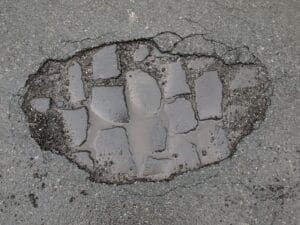
Potholes in asphalt roads and parking lots are usually a sign of a number of factors at play. Most commonly, they’re caused by gradual wear and tear over time. Sometimes, poor construction and structural weakness can also be the culprit. Whatever the cause is, potholes can do a lot of damage to vehicles that inadvertently drive over them. No matter how hard drivers try, it’s not always possible to bypass a pothole as there could be oncoming vehicles and other obstacles in the way. Trying to bypass potholes can also lead to dangerous driving conditions that can cause motorists to lose control of the vehicle.
The solution isn’t simply to ignore potholes and let them get worse over time. Instead, we should focus more on pothole repair and proper
asphalt pavement maintenance to prevent them from developing in the first place. In this article, we’ll discuss the causes of potholes on roads and in parking lots as well as their impact and how to repair asphalt potholes.
What Is a Pothole?
Potholes are large depressions in asphalt pavements. They typically start off as minor cracks in the pavement and can quickly widen over time due to natural wear and tear, water infiltration, and the pressure of vehicles driving over them. Once water permeates the surface of the asphalt pavement, it can freeze. Ice formations beneath the surface of the asphalt cause the subgrade to expand and leads to tributary cracks forming, which weaken the structural integrity of the asphalt pavement.
When the ice eventually melts, that runoff water will continue to move through those newly formed miniature cracks and the cycle of freezing and melting will continue until the internal cracks have spread throughout the entire property. Of course, this is a worst case scenario assuming that the initial pothole is neglected instead of being immediately repaired.
Potholes only get worse with more road and parking lot usage. Vehicles that drive over them can slowly chip away more and more chunks of asphalt, which allows the potholes to get bigger.
Since freezing water is the main cause of pothole formations, they tend to form more frequently during the winter months. Unfortunately, they only become noticeable in the spring once all of the snow has melted away. Drivers should be especially mindful of potholes on the road and in parking lots during the first few weeks of spring when property owners and municipalities are still in the process of repairing potholes and other winter damages.
What Causes Potholes on Commercial Asphalt Parking Lots?
Pothole formations can occur for a number of reasons. As mentioned, the main cause of potholes on asphalt roads and
parking lots is water infiltrating the surface of the pavement. However, there are other reasons that potholes can form.
High Traffic Volume
Asphalt roads and parking lots that get a high volume of vehicular traffic on a regular basis are more likely to sustain natural wear and tear and damages over time. Cracks and potholes are some of the most common asphalt damages that can occur on an
asphalt pavement.
Heavy vehicles like vans, SUVs, pickup trucks, cargo trucks, delivery trucks, and other industrial transportation vehicles can all place a great deal of pressure on an asphalt pavement. The more these vehicles drive over the same weak spots in the pavement, the more likely those portions are to cave in gradually over time. Eventually, dips and depressions will begin to form. As the asphalt continues to bend under the pressure, it will become increasingly brittle, which leads to cracking and crumbling. Pieces of asphalt may even start to break off every time a vehicle drives over that that same spot.
Add a variety of harsh weather conditions such as strong UV rays from the sun, sudden cold snaps, heavy rain, snow, and ice into the mix and you’ve got a recipe for a pothole.
Poor Construction
All asphalt pavements need a strong aggregate and sturdy foundation to support the constant weight of the structure and everything else (e.g., buildings, lampposts, vehicles, loading docks, etc.) that stands on it. Without a strong and well-constructed foundation, the entire structure could start to show signs of premature wear and tear and distress after just a few short months of operation.
Some asphalt companies run on very tight deadlines and will perform subpar subgrade overlay work or applications just to get the job done faster and move on to the next project. While expediency can certainly save a lot of time and money, it also results in low-quality work and some important application steps could be missed along the way.
To ensure the longevity and sturdiness of your asphalt pavement and prevent future headaches, it’s in your best interest to hire a reputable asphalt pavement contractor in your area who has a good track record of producing high-quality work consistently.
Water Infiltration and Erosion
Going back to the main cause of asphalt pavement degradation, we’d be remiss not to reiterate that water is public enemy number one when it comes to the degradation and destruction of asphalt. Standing or pooling water is particularly worrisome as it indicates that there could be deeper structural problems already afoot with your asphalt pavement structure.
Pre-existing dips and depressions in your asphalt pavement indicate that there are weak spots in the structure. As these spots continue to weaken over time, they form even deeper grooves that collect rainwater, which we’ve already established can cause tremendous damage to your asphalt.
The longer standing water stays on your asphalt, the heavier it gets and vehicles driving over these puddles only cause more distress. Large amounts of standing water on your asphalt pavement will eventually buckle, leading to large potholes and heavy water infiltration.
How Do Potholes Impact Vehicles?
Potholes on asphalt roads and in parking lots can impact vehicles in a number of ways. The damages to vehicles that drive over potholes can range from minor to severe. Here are the different types of vehicular damages caused by potholes.
Suspension Damage
Vehicle suspension consists of a network of different components including tires, linkages, springs, shock absorbers, and tire air. This network is responsible for minimizing the impact of bumps on the road to make your drive as smooth as possible. Hitting a deep pothole can throw the entire system out of alignment by damaging your shocks and ball points. This can cause your vehicle to drive off center and you may even notice some unusual whirring noises and vibrations.
Exhaust Pipe Damage
Located on the undercarriage of the vehicle, the exhaust pipe can absorb the brunt of the impact when you drive over a pothole. Driving over a large pothole causes your vehicle to dip lower down to the ground, which can cause the exhaust pipe to scrape against the pavement. Damage to your exhaust pipe, catalytic converter, or muffler could result in reduced engine power, loud whirring noises, and toxic black smoke being released from the back of your vehicle.
Body Damage
Superficial damages to the body of your car may not seem like such a big deal, but they can diminish the value of your vehicle over time. Scrapes, scratches, rust, and peeling paint can all leave unsightly marks on your vehicle. Pride of ownership entails taking good care of your vehicle even when it sustains body damage caused by driving on uneven roads that are littered with cracks and potholes. Cars that are low to the ground, such as sedans, are more likely to sustain superficial body damage than larger vehicles that are higher up off the ground.
How to Repair Potholes on an Asphalt Commercial Parking Lot
Here is a step-by-step guide on how to repair
asphalt parking lot potholes.
Clean Out Debris from the Pothole
Before you can seal up the pothole, it’s important to carefully and thoroughly clean out any debris that may be stuck inside. This can include organic matter, litter, and even water.
Sealing
Once all of the dirt and debris has been removed from the pothole, you have to apply a durable crack sealer to prevent new debris and water from penetrating the surface. Although it doesn’t offer any structural support or reinforcement, crack or slurry sealing does provide temporary, but long-term protection from future damages including water infiltration.
Apply an Overlay and Patching
Asphalt overlays are a much more durable and specially engineered reparative treatment in which a new aggregate is created to seal the surface of the pothole. This new aggregate also provides structural security to prevent the asphalt from caving in
Patching is more of a quick pothole repair method that involves applying either a hot or cold asphalt mixture and compacting it directly into the pothole to completely seal it and create a smooth surface.
Contact an Expert Asphalt Pavement Contractor for Pothole Repairs on Your Commercial Parking Lot
When it comes to high-quality and long-lasting
pothole repairs in Toronto, there’s only one name you should trust:
Sure-Seal Pavement Maintenance Inc. Having been in the asphalt business for more than 25 years, we have a reputation for offering one of the best asphalt road and parking lot maintenance services in the GTA. We even have an A+ rating on BBB to prove it.
Contact us today to get a quote!
 Potholes in asphalt roads and parking lots are usually a sign of a number of factors at play. Most commonly, they’re caused by gradual wear and tear over time. Sometimes, poor construction and structural weakness can also be the culprit. Whatever the cause is, potholes can do a lot of damage to vehicles that inadvertently drive over them. No matter how hard drivers try, it’s not always possible to bypass a pothole as there could be oncoming vehicles and other obstacles in the way. Trying to bypass potholes can also lead to dangerous driving conditions that can cause motorists to lose control of the vehicle.
The solution isn’t simply to ignore potholes and let them get worse over time. Instead, we should focus more on pothole repair and proper asphalt pavement maintenance to prevent them from developing in the first place. In this article, we’ll discuss the causes of potholes on roads and in parking lots as well as their impact and how to repair asphalt potholes.
Potholes in asphalt roads and parking lots are usually a sign of a number of factors at play. Most commonly, they’re caused by gradual wear and tear over time. Sometimes, poor construction and structural weakness can also be the culprit. Whatever the cause is, potholes can do a lot of damage to vehicles that inadvertently drive over them. No matter how hard drivers try, it’s not always possible to bypass a pothole as there could be oncoming vehicles and other obstacles in the way. Trying to bypass potholes can also lead to dangerous driving conditions that can cause motorists to lose control of the vehicle.
The solution isn’t simply to ignore potholes and let them get worse over time. Instead, we should focus more on pothole repair and proper asphalt pavement maintenance to prevent them from developing in the first place. In this article, we’ll discuss the causes of potholes on roads and in parking lots as well as their impact and how to repair asphalt potholes.

